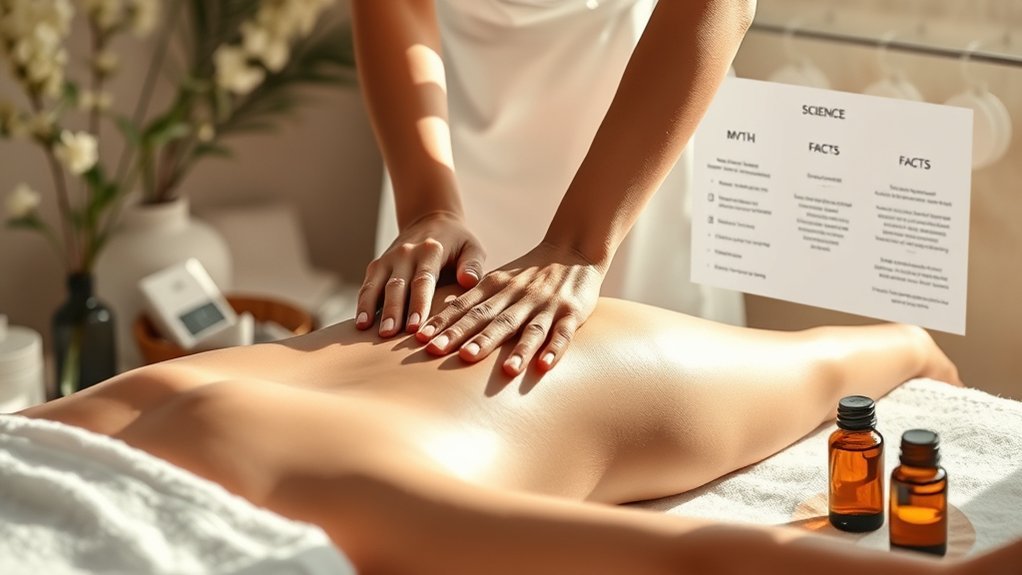Perineal massage can enhance your childbirth experience, reduce tearing, and promote healing. Yet, many misconceptions surround it, leading to confusion and hesitation. You might think it’s only for first-time mothers or that it’s painful, but that’s far from the truth. Understanding the facts is essential for making informed decisions about your pregnancy journey. So, what exactly should you know about this beneficial technique?
What Is Perineal Massage?

Perineal massage is a technique designed to stretch and soften the perineum, the area between the vagina and anus. This practice can help you prepare for childbirth by increasing flexibility and reducing the risk of tearing during delivery.
Research shows that regular perineal massage in the weeks leading up to labor can improve your chances of having an intact perineum. By gently massaging the area, you can also promote blood flow and enhance tissue elasticity.
It’s important to approach this technique with care, using clean hands and a water-based lubricant to guarantee comfort. If you’re unsure about how to perform it effectively, consider discussing with your healthcare provider—they can provide guidance tailored to your needs and circumstances.
Common Myths About Perineal Massage

You might believe that perineal massage is a painful experience, or that it’s only beneficial for first-time mothers.
Many also think you need professional help to perform it effectively.
However, understanding these myths can help you feel more empowered and informed about your choices.
Painful Experience Assumption
While many expect perineal massage to be a painful experience, this assumption often stems from misinformation and fear. In reality, when done properly, perineal massage can be a comfortable and beneficial practice. It’s important to approach it with the right techniques and mindset. Here’s a comparison of common misconceptions versus the reality:
| Myth | Fact |
|---|---|
| It always hurts. | Pain can be minimized with proper techniques. |
| It’s only for certain women. | Anyone can benefit from it with practice. |
| You need a partner to do it. | It can be done solo with guidance. |
| It requires special tools. | Just your hands and some lubricant are enough. |
| It’s not worth the effort. | It can lead to a smoother delivery experience. |
Understanding this can help ease your concerns and encourage you to try it.
Only for First-Time Mothers
Many assume that perineal massage is only beneficial for first-time mothers, but that’s a misconception.
Regardless of your birthing history, perineal massage can help prepare your body for delivery. It can improve elasticity and increase blood flow, which may reduce the risk of tearing during childbirth, whether it’s your first baby or your fifth.
Experienced mothers can also benefit from the practice, as each birth can present unique challenges.
By incorporating perineal massage into your routine, you’re not only promoting your body’s readiness but also fostering a sense of control and connection during pregnancy.
Requires Professional Assistance
Contrary to popular belief, perineal massage doesn’t require professional assistance to be effective. You can perform it on your own or with a partner, making it accessible for anyone interested in preparation for childbirth. Research shows that regular practice can reduce the risk of tearing during delivery, enhancing your overall birth experience.
Here’s a quick comparison of self-massage versus professional massage:
| Self-Massage | Professional Massage | Benefits |
|---|---|---|
| Convenient and private | Guided and knowledgeable | Reduces anxiety and builds confidence |
| Cost-effective | Potentially more expensive | Personalized techniques |
| Empowers you | Relies on external help | Strengthens connection with your body |
With practice and patience, you can confidently incorporate perineal massage into your routine.
Evidence-Based Benefits of Perineal Massage

Perineal massage offers several evidence-based benefits that can enhance your childbirth experience. Research indicates that regular perineal massage during pregnancy can greatly reduce the risk of perineal tearing during delivery.
Here are some key advantages:
- Increased elasticity: Regular massage helps soften and stretch the perineal tissues, making them more flexible during childbirth.
- Reduced need for interventions: Women who practice perineal massage often experience fewer episiotomies and assisted deliveries, leading to a more natural birthing process.
- Improved postpartum recovery: Engaging in perineal massage may lead to a quicker recovery, reducing discomfort and promoting overall healing after childbirth.
How to Perform Perineal Massage Safely
To reap the benefits of perineal massage, it’s important to know how to perform it safely and effectively.
First, wash your hands thoroughly and make sure your nails are trimmed to avoid any irritation. Use a water-based lubricant to reduce friction and enhance comfort.
Find a comfortable position—lying on your back with your knees bent or sitting in a relaxed position works best.
Gently insert your thumbs about 1 to 2 inches into your vagina, pressing down and toward your anus. Apply gentle pressure and massage the perineum in a U-shape for about 5-10 minutes, focusing on relaxation.
Listen to your body; if you feel any pain, stop immediately. Consistency is key, so aim for regular practice to maximize benefits.
When to Start Perineal Massage During Pregnancy
Starting perineal massage during pregnancy can be beneficial for preparing your body for labor and delivery. Ideally, you should begin around 34 weeks of pregnancy, as this allows your body to adapt and respond positively.
Consistency is key, so aim for a few times a week.
Here are some helpful tips to reflect on:
- Timing: Choose a relaxed time when you won’t be rushed or distracted.
- Comfort: Use a comfortable position, like lying on your side or squatting, to make the process easier.
- Practice: Incorporate deep breathing techniques to enhance relaxation and increase blood flow to the perineal area.
Potential Risks and Considerations
While perineal massage can offer many benefits, it’s crucial to be aware of potential risks and considerations. You should consult your healthcare provider before starting, especially if you have certain medical conditions. It’s vital to use clean hands and tools to minimize infection risk. Additionally, if you experience pain or discomfort, stop immediately and reassess your technique.
Here’s a quick overview of potential risks:
| Risk | Consideration |
|---|---|
| Infection | Guarantee cleanliness and hygiene |
| Discomfort or Pain | Adjust technique or consult a professional |
| Emotional Discomfort | Communicate openly with your partner or provider |
Personalizing Your Approach to Perineal Massage
How can you tailor perineal massage to suit your individual needs and comfort? It’s important to listen to your body and adjust techniques accordingly. Consider the following strategies to personalize your approach:
- Find the Right Position: Experiment with different positions, such as sitting or lying down, to discover what feels best for you.
- Use Appropriate Lubrication: Choose a lubricant that you find comfortable, whether it’s oil-based or water-based, to enhance the experience.
- Adjust Pressure and Duration: Start gently, and gradually increase pressure and duration based on your comfort level.
Frequently Asked Questions
Can Perineal Massage Be Performed by a Partner?
Yes, your partner can perform perineal massage. It’s often beneficial, fostering intimacy and comfort. Make sure you both communicate openly about preferences, ensuring a positive experience that supports relaxation and readiness for childbirth.
How Often Should I Do Perineal Massage?
You should perform perineal massage about once a day, starting around 34 weeks of pregnancy. This routine can help increase flexibility and reduce the risk of tearing during childbirth. Always consult your healthcare provider first.
Is It Safe to Use Oils During Perineal Massage?
Using oils during perineal massage can be like adding a gentle balm to a rough surface—it’s safe and can enhance comfort. Just choose natural, unscented oils to avoid irritation and guarantee a smooth experience.
Will Perineal Massage Hurt?
Perineal massage might feel uncomfortable at first, but it shouldn’t hurt. With gentle techniques and practice, you can ease tension and enhance flexibility. Listening to your body’s signals is key to a positive experience.
Can Perineal Massage Help With Postpartum Recovery?
Yes, perineal massage can aid postpartum recovery. Studies show it may reduce perineal pain by 30%. It helps promote healing and flexibility in the area, supporting your body’s natural recovery after childbirth. You deserve comfort!
Conclusion
Incorporating perineal massage into your pregnancy routine can be as essential as packing your hospital bag. By understanding the facts and dispelling the myths, you empower yourself to enhance your childbirth experience. This simple, accessible practice can lead to greater comfort and reduced risk of tearing. Remember, every woman’s journey is unique, so personalize your approach. Embrace this opportunity to connect with your body and prepare for a smoother delivery.
